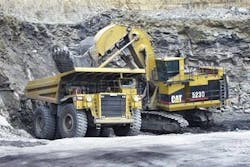On fire a little more than one year ago, the OTR tire market in North America is now suffering from lack of demand due to the intense global recession. Mining activity is down, housing starts are virtually nonexistent, and large-scale construction and repair projects that are expected to be financed by the federal government’s stimulus package have yet to begin.
Where does this leave OTR tire manufacturers and dealers? In a somewhat uncomfortable limbo, according to executives from various OTR tire suppliers who recently spoke with MTD Senior Editor Mike Manges.
In this www.moderntiredealer.com exclusive, these executives share their thoughts about the present state of the OTR tire market in North America and where things are headed. Participants included Manny Cicero, president of Alliance Tire USA; Jack Fenner, sales, Balkrishina Industries Ltd. (BKT-Tyres); Shawn Rasey, president, Off-Road Tire, Bridgestone Americas Tire Operations; Roger Lucas, vice president of sales and marketing, Michelin Earthmover Tires; and Nelson Richards, OTR national sales manager, Yokohama Tire Corp. (Bill Haney, sales manager for BKT, answered the third question on behalf of his company.) Here’s what they had to say:
1. What is the state of the OTR tire market?
Cicero: Construction is moribund – all but dead. With the ripple effect of the economy on demand for raw materials, underground and open pit mining also appear to be down. Like any recession, this part of a cycle.
Fenner: The overall market is still struggling due to economic conditions. Construction and quarry demand continue to be off. This business has always been cyclical and there are signs of improvement. The federal stimulus package will certainly help the small and medium size OTR lines that are offered by the majority of OTR tire dealers. However, it will take some time for these monies to be released and more time to see this flow into OTR tire demand.
Lucas: The OTR market in the U.S. is significantly down year-over-year. However, the level of decrease varies greatly based on the market segments. Higher than normal inventories in the OE and replacement channels have exacerbated this decline. There have been some bright spots with the stabilization of minerals and energies, which has provided for relatively steady demand in the mining operations.
Rasey: Overall, I would describe the North American OTR tire market as stressed due to the effects of a stagnant economy. Almost every segment of the OTR market has experienced moderate to extreme downturns in demand. The replacement market, while off significantly from 2008, has been more resilient than sales to the OE market. The good news is that we are starting to see some small, positive signs of recovery, but recovery won’t happen overnight.
Richards: The OTR market has not improved since the first of the year, and in fact, is off substantially from this time one year ago.
2. What is the biggest challenge facing OTR tire manufacturers and dealers right now?
Cicero: Many dealers have inventory that they purchased during the shortage of product that they are now holding. We’re trying to shoulder some of that burden for our dealers with our warehouse in Tennessee.
Fenner: The biggest challenge for all is to effectively manage our businesses. Both manufacturers and dealers need to stay close to their customers. Manufacturers need to understand what their dealers are facing and find ways to improve on their relationships. Now is the time for dealers to get back to the basics. This means not only staying close to their customers, but revisiting their fleet inspection programs, tire maintenance programs, retreading opportunities, fitment guidelines, training programs and all over service-related items that will assist their customers in improving overall costs. The dealer who focuses his efforts in these areas will be rewarded.
Lucas: With such market volatility, it is important to manage inventory levels to a point where market demands can be met, yet still maintain fiscal responsibility. The challenge lies in our ability and the ability of our distribution network to understand the needs of our customers. Based on those needs, we must ensure the availability of products and services to meet customers’ expectations. Given today’s economic climate, it also is important to continue to offer value-added services and ensure long-term operational cost controls.
Rasey: It’s clearly lack of demand. For manufacturers, (the challenges are) costs associated with balancing inventories and matching production with demand. For dealers, it’s the need to reduce excess inventories, much of which has already occurred during the first half of 2009. But in my view, there is still work to do in this area, especially for dealers who may have bought excessive inventory during the boom cycle.
Richards: The biggest challenge is the excess of inventory left over from the buying frenzy a couple of years ago. Because of the downturn in business, dealers and manufacturers alike have had to manage the costs of their day-to-day activities without cutting back dramatically on service.
3. Do you expect the market to improve?
Cicero: OTR-related industries fell quickly and deeply. But federal stimulus finds are making their way down the line to projects around the country. I don’t think we’ve felt it yet, but you can’t put $787 billion into the economy and not expect it to have some jump start on demand. I think it will be turning around soon. We’re hoping we’ll see it by the fourth quarter.
Haney: We see the market for value-driven OTR products as good.
Lucas: We do believe that markets will improve, though the timeline for this improvement is uncertain. However, as we work through inventories in both the OE and replacement markets – and as markets appear to be stabilizing – we believe the second half of 2009 should provide a show of improvement vs. the first half.
Rasey: The market will improve; the big questions are when and how quickly. I think the reason we’ll see recovery is based on the reality that the fundamentals are still strong. Continued global population growth, the positive rate of decreasing poverty and the dramatic trend toward urbanization in emerging economies all point toward a continued demand for energy and finished goods that are built with the commodities that our industry serves. Based on our analysis of the market, we expect to see modest improvements through the second quarter of 2009, but don’t look for any significant break-out this year. By mid-2010, we should see inventories in balance, a recovery in demand that is more sustainable, and overall a more positive business environment.
Richards: Moving forward, 2009 will finish as it started: slow. As of right now, there are no signs that the construction or mining industries will improve. Predictions are that 2010 will improve some, but until banks begin to lend money to promote growth, progress will be minimal.



